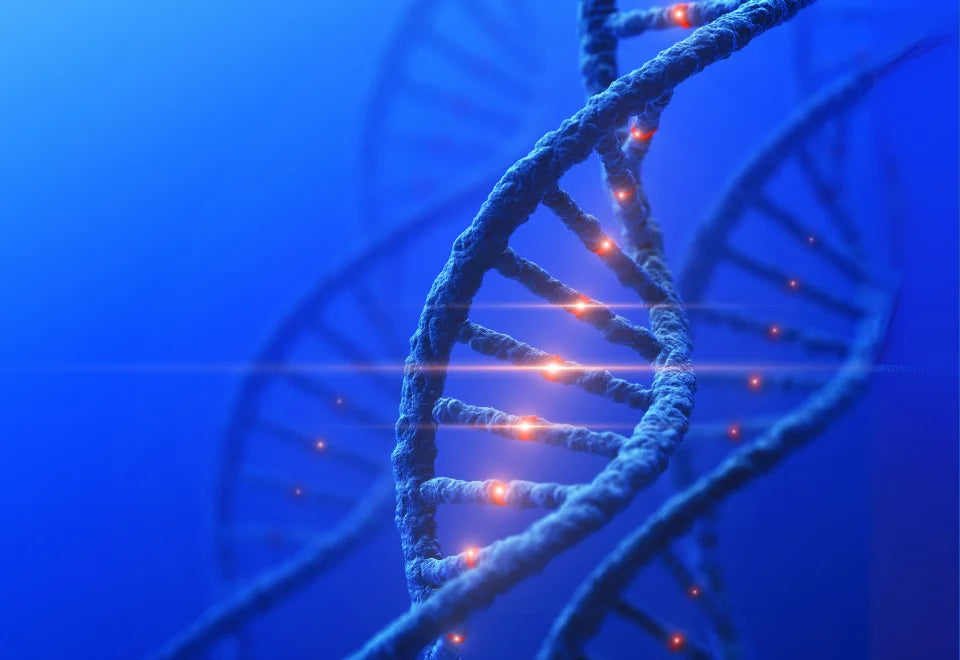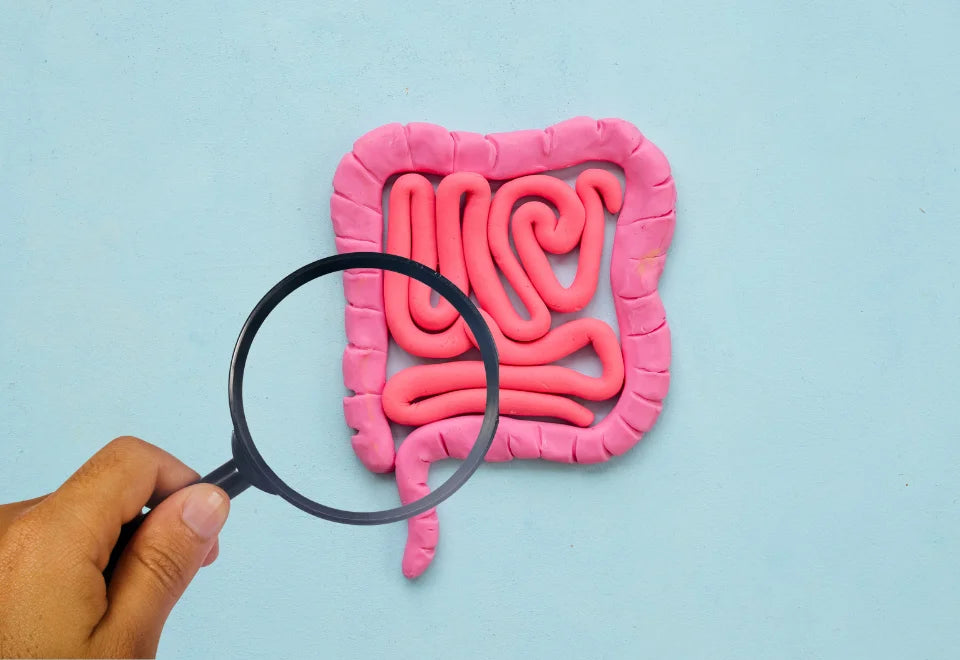The gut microbiome and mitochondria are closely connected systems that influence ageing and overall health. As we age, disruptions in these systems lead to reduced energy production, increased inflammation, and greater vulnerability to age-related diseases.
Solutions to Slow Ageing:
- Diet: High-fiber diets and fermented foods boost microbial diversity and mitochondrial activity.
- Supplements: Urolithin A, CoQ10, and probiotics improve energy production and reduce inflammation.
- Testing: Advanced diagnostics identify gut and mitochondrial imbalances for personalized treatments.
Maintaining the microbiome-mitochondria balance is key to mitigating ageing effects and improving long-term health.
How Microbiome and Mitochondria Work Together
Key Microbiome Products That Affect Mitochondria
The gut microbiome produces compounds that directly influence how mitochondria function. For example, short-chain fatty acids (SCFAs), especially butyrate, play a role in boosting mitochondrial activity by activating AMPK pathways. Research shows that butyrate can increase ATP production by 40% in colonic cells through HDAC inhibition [1].
Another important compound is urolithin A, which comes from ellagitannins found in foods like pomegranates. Clinical trials reveal that urolithin A improves mitochondrial performance by 25% in older adults [2]. Additionally, the microbiome generates NAD+ precursors, which help repair mitochondrial DNA.
| Metabolite | Primary Function | Impact on Mitochondria |
|---|---|---|
| Butyrate | AMPK activation | 40% boost in ATP production |
| Urolithin A | Supports mitophagy | 25% improvement in performance |
These beneficial effects stand in stark contrast to the negative impact mitochondrial issues can have on gut bacteria.
Effects of Mitochondrial Problems on Gut Bacteria
When mitochondria start to malfunction, the gut microbiota feels the effects. Research involving ATP-synthase 8 mutations shows that impaired oxidative phosphorylation leads to notable changes in microbiome composition. For instance, Bacteroidales populations increased by 40%, while Desulfovibrionaceae numbers doubled compared to healthy controls [3].
These microbial shifts can worsen systemic stress, fueling inflammation and oxidative stress pathways.
"Mitochondria retain microbial-like stress response pathways that remain responsive to bacterial metabolites even in human cells." - Frontiers in Microbiology Review [4]
2-Way Effects on Inflammation and Oxidation
The interaction between mitochondria and the microbiome creates a feedback loop involving inflammation and oxidative stress. Mitochondria produce reactive oxygen species (ROS), which activate NLRP3 inflammasomes and weaken the gut barrier. At the same time, microbiome-derived lipopolysaccharides (LPS) trigger TLR4 signaling, disrupting mitochondrial membranes [1].
This two-way communication becomes especially important in ageing and disease. For example, SCFA supplementation has been shown to lower inflammatory markers (IL-6, TNF-α) by 35-50% in older animal studies [5]. In disease contexts, 60% of Multiple Sclerosis patients exhibit abnormal gut microbiota linked to mitochondrial complex I dysfunctions [4].
In lab studies using human colonic organoids, harmful bacteria like Fusobacterium increased hydrogen sulfide production by 300%, disrupting mitochondrial membrane potential in 90% of cells within just 48 hours [5].
Effects on Ageing Process
Changes in Mitochondrial Function with Age
As we age, mitochondrial function declines significantly across various tissues. For instance, research indicates that skeletal muscle experiences a 30-50% drop in oxidative phosphorylation (OXPHOS) capacity, which directly reduces energy production. In microbiome-depleted intestinal cells, ATP generation can fall by as much as 40% [3][6].
This decline is further worsened by mitochondrial DNA damage. Ageing tissues accumulate oxidative damage to mitochondrial DNA at rates 10-20 times higher than nuclear DNA. This damage contributes to gut imbalances, creating a cycle of reduced energy production and chronic inflammation.
| Mitochondrial Change | Cellular Impact |
|---|---|
| OXPHOS Reduction | Energy production drops by 30-50% |
| DNA Mutation Rate | Increases by 2-3x in aged tissues |
| Complex IV Activity | Falls by 40% due to elevated trimethylamine N-oxide (TMAO) |
Gut Bacteria Changes and Inflammation
Ageing also disrupts gut bacteria, with elderly individuals showing a 60-80% decline in short-chain fatty acid (SCFA) producers. This microbial imbalance triggers inflammation, suppressing mitochondrial sirtuin-3 activity by 40%, tripling IL-6 levels, and reducing mitophagy (cellular cleanup) efficiency by 35% [7][8][9].
Connection to Age-Related Diseases
Shifts in gut bacteria and mitochondrial function are closely tied to age-related diseases. For example, reduced microbial diversity is linked to mitochondrial enzyme deficiencies in Alzheimer’s disease (AD) brains. Studies highlight:
| Disease Marker | Change Observed |
|---|---|
| Microbial Diversity | Reduced by 50% |
| Cytochrome c Oxidase Deficiency | 3x higher in AD brains |
| Brain Glucose Metabolism | 72% correlation with microbiome changes |
In metabolic disorders, frail elderly individuals show a 60% reduction in Akkermansia muciniphila, a key bacterium for gut barrier health [10]. This correlates with a 45% drop in muscle OXPHOS capacity [6] and a 30% decline in hepatic NAD+ levels [9].
Mitochondrial repair also suffers with age. Elevated trimethylamine N-oxide reduces Complex IV activity in heart mitochondria by 40% [7]. On the flip side, metabolites like propionate can counteract harmful mitochondrial fission by 50% through HDAC6 suppression [9].
Current Treatment Options
New methods are focusing on the connection between the microbiome and mitochondria, using three main approaches:
Diet and Probiotic Treatments
Eating a high-fiber diet (30-40g/day) can increase microbial diversity by 25-40% and improve mitochondrial complex I activity. Fermented foods help lower oxidative stress by 15-20% [3][10][8]. The probiotic strain Bifidobacterium longum 1714 has been shown to reduce intestinal permeability by 30% while supporting mitochondrial membrane potential [3][10].
| Dietary Component | Effect on Microbiome-Mitochondria Axis |
|---|---|
| High-fiber Diet (30-40g/day) | Increases microbial diversity by 25-40% |
| Fermented Foods | Decreases oxidative stress by 15-20% |
| Multi-strain Probiotics | Boosts cellular energy production by 18% |
| Resistant Starches | Enhances SCFA production by 22% |
Mitochondrial Health Supplements
Combining galactooligosaccharides (5g/day) with pyrroloquinoline quinone (20mg/day) has been shown to increase bifidobacteria by 40% and improve mitochondrial respiration by 32% in adults over 65 [10][6].
Urolithin A (500mg daily) supports gut microbial diversity by 22% and improves mitophagy efficiency [2][4]. NMN (300mg/day) enhances fecal butyrate levels by 35%, thanks to its role in NAD+-dependent microbial interactions [2]. Coenzyme Q10 supplementation has shown a 27% boost in mitochondrial complex II activity while balancing the Bacteroidetes/Firmicutes ratio [3][6].
Testing and Solutions
Advanced diagnostics now allow for tailored treatments. Advanced gut microbiome testing identifies deficits in SCFA-producing bacteria tied to mitochondrial DNA variations.
Next Steps in Research
Although current therapies show promise, several key areas of research must be tackled to push microbiome-mitochondria interventions forward.
Long-Term Human Studies Needed
Research involving C57BL/6J strains with ATP-synthase 8 gene mutations has delivered encouraging results, but human studies are still missing.
Gaps in Mitochondrial DNA Research
The role of mitochondrial DNA variations in shaping microbiome composition remains underexplored. Early studies indicate that haplogroups J and H may influence oxidative stress responses and microbial diversity in distinct ways [7].
"Current research frameworks inadequately address dual-inheritance systems, particularly regarding shared inheritance patterns affecting both mitochondrial function and early microbial colonization" [10]
To fill this gap, we need studies that connect specific mtDNA variants to long-term microbiome changes, especially in older adults. These insights could pave the way for tailored treatments.
Improved Testing Methods Are Crucial
Developing better diagnostic tools is essential for accurately measuring microbiome-mitochondria interactions.
To speed up progress, collaboration across disciplines is vital. For instance, single-cell sequencing can track mitochondrial mutations, while integrated metatranscriptomics-respirometry connects microbial activity to energy production. Unified testing protocols could help decode how these systems interact during ageing.
Conclusion: Improving Health Through Microbiome-Mitochondria Balance
The connection between mitochondria and the gut microbiome offers new insights into managing age-related health issues. Studies show this relationship is more than just coexistence - it plays a key role in ageing and overall health.
This two-way interaction can create both risks and opportunities as we age. Declining mitochondrial function impacts gut microbiota composition, leading to a chain reaction of health effects.
Data from centenarians, showing 23% more butyrate producers (see Introduction), highlights the importance of Akkermansia in supporting mitochondrial health. This discovery points to microbiome-based approaches for promoting longevity.
Although standardizing biomarkers remains a hurdle, research continues to identify new therapeutic possibilities. Personalized treatments aimed at improving this microbiome-mitochondria connection are steadily advancing.
FAQs
What is the connection between the gut microbiome and mitochondria?
The gut microbiome and mitochondria are closely linked in maintaining overall health, particularly in ageing. The microbiome produces metabolites like short-chain fatty acids (SCFAs) and urolithin A that support mitochondrial function. In turn, mitochondrial activity influences the gut microbiota's health by regulating oxidative stress and inflammation.
How does the gut microbiome affect mitochondrial function?
The gut microbiome produces SCFAs like butyrate, which activate AMPK pathways to boost mitochondrial energy production. Urolithin A, derived from foods like pomegranates, also supports mitochondrial repair by enhancing mitophagy, which is the process of removing damaged mitochondria.
How does mitochondrial dysfunction impact the gut microbiome?
When mitochondria malfunction, such as through mutations that impair oxidative phosphorylation, the gut microbiome is disrupted. This can lead to shifts in microbial populations, increasing inflammation and oxidative stress, which further exacerbates mitochondrial dysfunction.
How does ageing affect the microbiome and mitochondria?
As we age, mitochondrial energy production declines by 30-50%, and oxidative stress increases, damaging both mitochondria and gut bacteria. SCFA-producing bacteria decrease by up to 80%, leading to inflammation, reduced mitophagy, and mitochondrial DNA damage, creating a cycle of health decline.
What are some natural solutions to mitigate the effects of ageing on the microbiome and mitochondria?
Dietary interventions such as high-fiber diets and fermented foods can improve microbial diversity and mitochondrial function. Supplements like urolithin A, CoQ10, and probiotics have been shown to enhance energy production and reduce inflammation.
Can supplements help with mitochondrial and microbiome health?
Yes, supplements like urolithin A (500mg/day), CoQ10, and NMN (300mg/day) can help improve mitochondrial function and microbial diversity. Urolithin A, for example, has been shown to enhance mitophagy, while CoQ10 boosts mitochondrial complex activity.
How does mitochondrial DNA damage contribute to ageing?
Mitochondrial DNA accumulates oxidative damage at higher rates than nuclear DNA with age. This damage reduces the efficiency of mitochondria, impairing energy production, and causing further damage to gut microbiota, creating a vicious cycle that accelerates ageing.
Can gut microbiome testing help personalize treatments?
Yes, advanced diagnostics that test the gut microbiome can identify imbalances in SCFA-producing bacteria and mitochondrial DNA variations. This allows for personalized treatment approaches to restore balance and improve health outcomes, particularly in older adults.
Are there any specific bacteria linked to better mitochondrial function in longevity?
Yes, studies show that centenarians have more butyrate-producing bacteria, such as Akkermansia muciniphila, which are linked to better mitochondrial function and health. These bacteria support the gut barrier and mitochondrial repair processes.
























Leave a comment
All comments are moderated before being published.
This site is protected by hCaptcha and the hCaptcha Privacy Policy and Terms of Service apply.